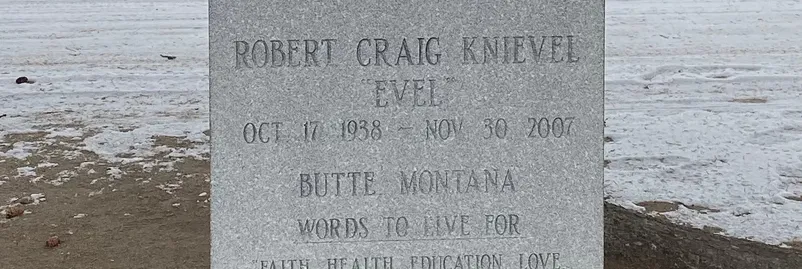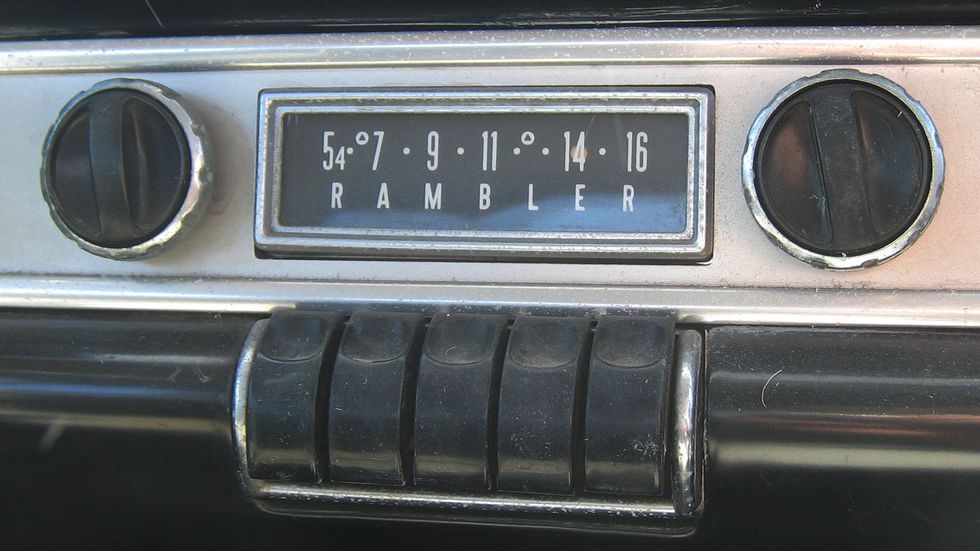In December I made a post-retirement pilgrimage to Montana to spend a few days in a place that gives me peace. Open ranges with grazing cattle, herds of elk, wandering pronghorn, deer, crystal clear trout waters, and most importantly - poor radio reception, and gaps in cell coverage. During my trips there I like to visit places I’ve never been to. This time I took a short drive to the historic bare-knuckle mining town, Butte. I drove the streets, checked out a used bookstore, and then went in search of the gravesite of the city’s famous son. The hard-living, hard-driving, motorcycle stunt driver, and fanciful showman, Robert “Evel” Knievel.
Knievel made 75 motorcycle jumps in a career that spanned from the 1960s to the later part of the 1970s. He leaped over cars, trucks, buses, and made an ill-fated jump over the fountain at Las Vegas’ Caesar’s Palace that left him with a crushed pelvis and femur, fractures to his hip, wrist, and both ankles and a concussion that put him in a coma. It wasn’t the first time he crashed or his last, and he would break and re-break many more bones. At the peak of his fame, he attempted to jump Idaho’s Snake River Canyon in a “rocket-cycle.” The stunt failed when the cycle’s parachute deployed on takeoff.
He was also a master of personal branding. When Evel intended to jump English buses in Wembley stadium and was confronted with a pre-sale of only 3000 tickets in a 100,000-seat venue, he took to the streets and undertook his own public relations campaign. Without the benefit of today’s social media megaphone, he filled Wembley with 80,000 people.
In a closing monologue voice-over in the 1971 biopic Evel Knievel, George Hamilton as Knievel sums up his role in society:
“Important people in this country … celebrities like myself, Elvis, Frank Sinatra, John Wayne, we have a responsibility. There are millions of people that look at our lives and it gives theirs some meaning. People come out from their jobs, most of which are meaningless to them, and they watch me jump twenty cars, maybe get splattered. It means something to them. They jump right alongside of me … they take the bars in their hands and for one split second they’re all daredevils.”
People may have lived vicariously through the last gladiator during his jumps, but they wouldn’t have wanted to live like him. The 2015 documentary Being Evel and Leigh Montville’s 2011 biography, Evel: The High-Flying Life of Evel Knievel: American Showman, Daredevil, and Legend reveals the sometimes-violent, philandering, criminal, conman, egotist in Knievel. But even with all this, we need more people like Evel.
Oh, we have enough daredevils. YouTube is filled with millions of videos of professional and amateur stunts. Some impressive, most just stupid. Politics and business have their share of philandering, criminal, egotistical, con artists. What we need are more people who mirror Knievel’s refusal to be boxed in by someone else’s idea of social norms and tradition.
At home, people are motivated by shares and re-tweets, likes and loves. At work, even though they’re encouraged by the tired and trite business mantras to “think outside the box” and “push the envelope,” they’re still restrained by corporate drones ready to shoot down their careers if they threaten someone else’s domain or self-imposed power. Although some refuse to be stopped by these invisible and senseless barriers and succeed, they are far outnumbered by those who play it safe. We are unwittingly becoming a risk-averse culture competing in daily popularity contests, afraid of who might disagree, take offense, or complain.
Evel is buried at the Mountain View Cemetery. A sign directs visitors to his gravesite. Despite his individual flamboyance in dress and mannerisms, other than some red white and blue bunting in a nearby tree, it’s fairly simple and understated. A single granite headstone that Evel had made right before the Snake River Canyon jump. It was intended to mark the site of his potential demise and was put into storage when his life didn’t end there. The side engraved before the jump has an image of the rocket cycle and identifies him as Robert ‘Evel’ Knievel, motorcyclist and daredevil, gives details of the jump, and has a simple quote over the image of an American flag, “A man can fall many times in life but he’s never a failure if he tries to get up.” The other side is the traditional name and dates of birth and death with “Words to Live For – Faith Health Education Love Honorability Dream Believe in Jesus Christ.”
Evel knew who he was, and regardless of what others thought, he wasn’t afraid to be that person. When asked why he put his life in danger his answer was, “I do it because I’m Evel Knievel and there’s something within me that makes me do it, and I don’t try to figure it out, I just try to do it the best I can.” Over the closing credits of the 1971 movie is a song inspired by Evel that includes the lyrics, “Sell your soul to the future, fortune and to fame, up your status and then they remember you as old what’s your name. So, I do what I please.” Play the game and in the end what will people remember?
Imagine the possibilities if instead of people modeling their lives after social media “influencers” whose actions are designed to please or allowing their actions to be dictated by a shallow corporate khaki lackey protecting their own status, they instead followed Knievel’s lead. They took a risk. Grabbed the handlebars of life’s ride, became a daredevil and jumped over the canyon of conformity.
We could use more Evel in this world.



